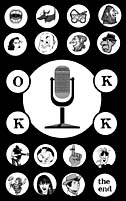
Comment
on this story
|
|

Theatre Central uses a Lone Star trio to flesh out Greater Tuna
by Adrienne Martini
Texas holds a strange place in the hearts of most non-Texans, and folks just keep writing plays about it. Witness Vanities or Lone Star or Greater Tuna, which is running at Theatre Central through Sept. 16. Those who've never lived in the Lone Star State just don't quite know how to fit its mythos into their consciousness. An example—a couple of years ago there was a marketing campaign for the state of Texas with the slogan: Texas—like a whole other country.
Come on, now. Texas is just like any other state in the union, despite allusions otherwise. Until further notice, Texans still use American dollars and are just as bewildered about the redesigned bills as Tennesseans are. Folks are born, live a bit, and die just like in the other 49. In the broadest possible terms, nothing happens there that doesn't happen anywhere else.
It may be, though, that Texans are better at designing their own mystique (and bragging about it) than those in other states. Never would you hear that, say, Pennsylvania was like a whole other country. The other UT (the other orange and white one from which I'm an alumna) commissioned a study a few years ago to redesign its logo and slogan. What the firm came up with was a stylized picture of the UT tower, from which Charles Whitman shot up the campus on a dark day in the '60s, and the words "We're Texas" running underneath. Simple, but effective—once you get over the simplicity and think it through. We're Texas, the whole state seems to be saying, and you're not.
The strangest piece of Texas bluster is that Texas was never intended to be just one state. When originally allowed into the United States, plans were drawn up (and were allegedly going to be imposed) dividing this vast patch of land into five reasonably-sized states. It makes sense, really, when you consider the different characters of Texas—there's Dallas and Houston, which are urban more than anything else; Austin and the Hill Country, which look an awful lot like East Tennessee with smaller, browner hills; the Panhandle, which loves its rednecks just as much as Knoxville does; San Antonio and points South, which retain the flavor of Old Mexico, and the vast expanse called West Texas.
In that expanse of dust and sulfur and more dust, Jaston Williams, Joe Sears, and Ed Howard set their Greater Tuna, a show about a tiny town out in the vastness called, you guessed it, Tuna. There's just something about the heat and isolation that has driven these Tunans a bit around the bend and we get to meet quite a few of 'em through the call-in shows on the 275-watt WOKKK. And, if the pictures painted by down-home hosts Struvie and Wheelis weren't enough, Williams and company also move us into some of this town's citizens' homes for some up close and personal looks at dysfunction among the West Texas tumbleweeds.
Tuna is one of those shows (Mystery of Irma Vep is the other that comes readily to mind) that require two amazingly talented actors who know how to take off their clothes in a hurry—since they play all of the two-dozen parts in the play. Williams and Sears did it for years both in regional venues and on Broadway. Mark Moffett's production at Theatre Central does it with three actors, which is still a stretch for the three involved but not nearly as chaotic as two can be. That, however, is not the most unique thing about Moffett's version. Instead of using men to play the roles, he has cast three women (Cherie Compton, Dottie Justice, and Kris Van Landingham) and changed the names of all of the male characters to female versions.
It's a strange choice and one that doesn't seem to make a whole lot of sense. Williams and Sears had no problem with playing the women or men who make up Tuna; Compton, Justice, and Van Landingham are certainly gifted enough to do the same. Granted, men in drag are inherently funnier (funnier ha ha, not funnier odd,) than women doing the same for some strange reason, but the jokes in the script are plentiful and don't need the extra level of gender bending.
Wisely, Moffett and the actors root the jokes in well-defined characters, instead of playing each character like the last and relying on the script to punch up flat acting with some jokes. Sure, there are exceptions—places where the characterization falls flat (like Compton's Patty Fisk)—but these women are juggling up to eight personas at any one time. Given that, their performances are remarkable. My one wish is that all three would slow down just a bit and concentrate on the words that are coming out of their mouths. While most of the humor comes from these wackos out in the West Texas plains, there are some turns of phrase that are downright hysterical just because of the way the words fall together.
But I still contend that Texas is no funnier (both funny ha ha and funny odd) than any other state and simply gets away with big heads and hair because Texans choose to make an issue of it. East Tennessee could be just as memorable—and some of the characters in Greater Tuna could fit right into our own little version of this play. Call it Greater Bass or somesuch. Hell, Dollywood alone could provide more than enough characters. Just think of the fun you could have if you threw in a Victor Ashe-type or a Todd Steed-type or a Bob Deck-type. It's what East Tennessee needs to put it on the map. But, until we get our own version, Greater Tuna is worth checking out.

August 31, 2000 * Vol. 10, No. 35
© 2000 Metro Pulse
|